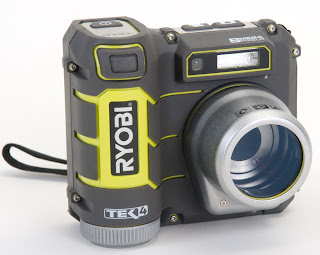

Now, you can find your new camera at Home Depot. Ryobi has long been known as a power hand tool maker, and one of the most innovative around. You can find their tools at Home Depot, alongside a new camera, the Ryobi Tek4 Durashot, or RP4200.
I've used Ryobi tools for over 20 years, generally with great satisfaction. I was skeptical but curious when I heard of the Durashot. It is designed for people who are apt to knock it around more than the average point and shoot user: there's a protective cover over the lens, and much rubber-like covering over the rest. It appears to be exceptionally well-sealed for a P&S, though I didn't leave it out in the rain or toss it in the tub to test. I also didn't test their one meter impact resistance. Water protection is supposedly good to a meter as well. At least partly because of the lens protector, it is most definitely not a pocket camera.
I haven't asked a Ryobi rep, but my guess is that the camera is directed at builders, contractors, DIYers and others who want a rugged camera to bump around a job site or a shop, something that can be tossed on a pick-up seat without worrying about scuffing and scarring and too easy breakage.
It feels fine in the hand, though it's close to twice the size of my wife's Canon A460 S&P. It's also almost twice the weight, at about 12.5 ounces versus just under 7 ounces for the little Canon.
For me, handling the larger camera is easier. For others, it won't be.
The directional arrows on the back have been moved off the OK button for easier operation. That works nicely. All of the controls work well. The control ergonomics appear well thought out, though after using a Pentax DSLR for more than half a decade, I had some fun getting used to--as I did with the A460, though.
The menu is simple and easy to follow. The LCD is 2.5 inches. There are eight effective mega pixels (8MP).
The camera comes with a battery and a charger, plus a one gig SD card, and a case. The battery is a lithium ion four volt, designed specifically for a line of small tools Ryobi is now manufacturing--items like the Tek4 Laser Distance Measure, Tek 4 Audio Plus noise suppression headphones (I'm really ready to try 'em an attempt to retain what's left of my hearing), and a self-leveling plumb & cross laser. All come with a battery charger and battery, but for fast charges, there is a dual battery 36 minute charger available. There's also a neat, small flashlight that's going in my camera bag.
Various scene modes are easy to use. I dislike the camera's dropping to the default setting whenever it is turned off. I have no idea what the default setting is, though it seems to work for many scenes.
Effectively, the lens, a 3X optical zoom, starts at 38mm (in 35mm terms)and screams outwards to 152mm (actually, it's 6.75mm-27mm). Digital zoom brings the total to 18X, with its 4.5 multiplier--my suggestion is that you forget about the digital zoom and just crop the photos. Same thing.
The macro setting works decently, as the license plate logo shows. Fastest aperture is f/3.5, dropping to f/5.15 fully racked out in telephoto.
In a few days, I'll post some more photos. At the moment, my lack of experience with P&S cameras is showing: almost everything is at least mildly blurred from movement. It would be unfair to post that as a sign of what this handy little camera can, or will, do. The sensor is a P&S, tiny at 1/2.35", but appears to be a good one. ISO ratings are Auto, 100, 200, 400, 800 and 1600. I haven't tried the two higher ranges--but I will. So far, I've never met a P&S that was any good at over ISO 400, though.
I may even try to work out the movie mode, which is claimed to give VGA resolution at 30 frames per second. Two frame modes exist: 320 x 240 and 640 x 480. With the included one gig memory card, you probably can get a decent length movie. Stick in a larger SD card for longer movies, though I doubt you'll expect to make a full length feature with the RP4200.
So far, I like the Ryobi. My biggest complaint is that the SD card doesn't pop far enough out when it's ejected. My clumsy fingers won't grab it. Otherwise, it's providing some fun, and may be useful shooting a couple of projects at other times.
More interesting features include a self-timer (2,5 and 10 second intervals) with time lapse intervals of 5 or 15 minutes, or one hour. You may also stick an audio memo on a photo if you think you'll forget some details.


